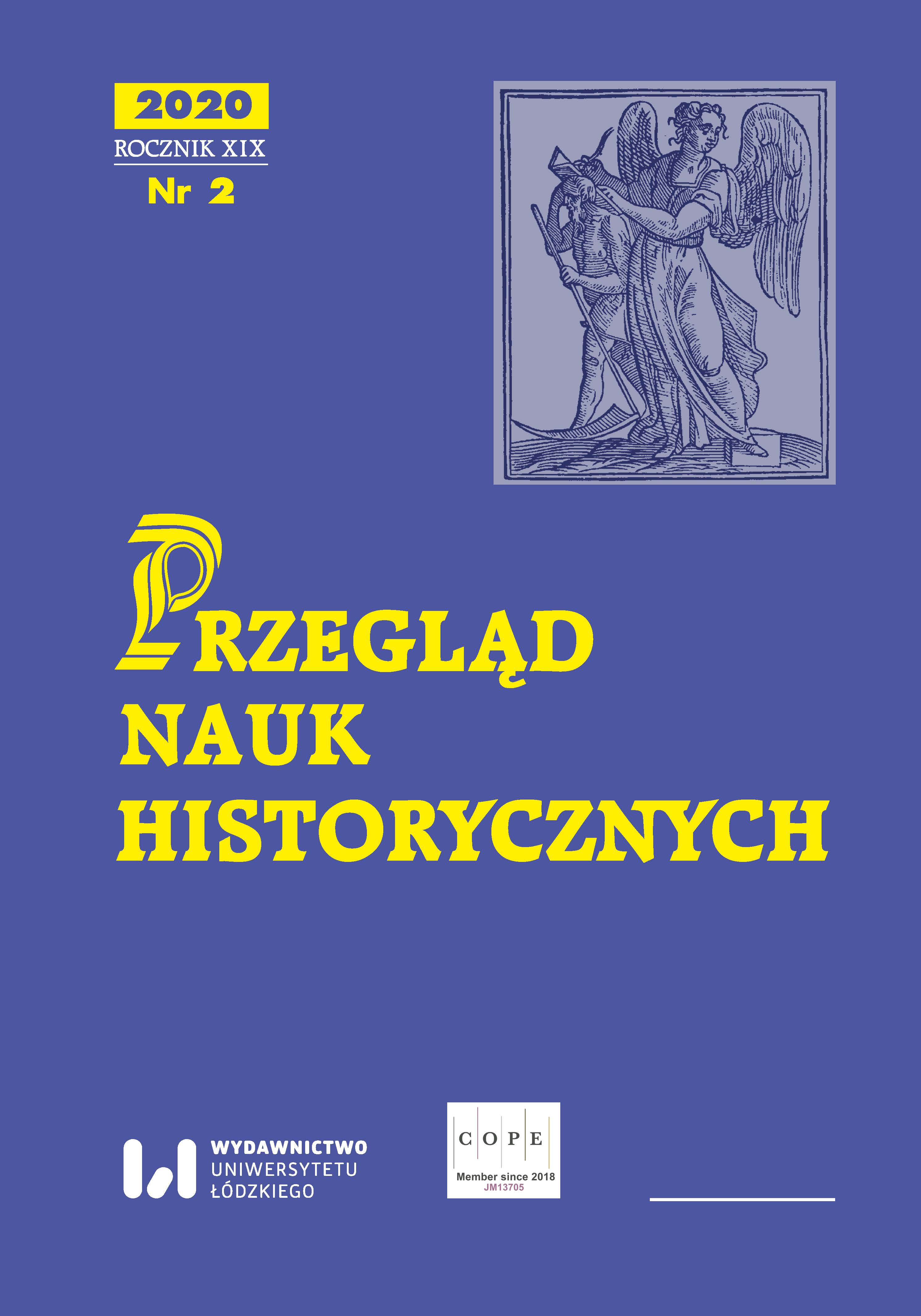Parents legitimatising children in the light of records of the Magistrate’s Courts of the Radomsko district in the years of 1845–1874
DOI:
https://doi.org/10.18778/1644-857X.19.02.11Keywords:
legitimatisation of children, illegitimate children, military service, court of peace, Radomsko district, 19th centuryAbstract
Protocols of legalisation created in the Peace Court of the Radomsko District in the years 1845–1874 allowed for analyses of persons deciding on this legal act. Based on 43 documents 49 persons legitimatising their children were established. They included 41 mothers and 8 fathers. Couples performed legitimatisation in 6 cases, only fathers in 2 cases, and mothers in 35 cases. The mothers had different marital status. Among them 11 were unmarried women, 16 were married and 14 were widows. Most often, therefore, they were mothers who were not married.
The age of 40 parents recognising children was determined. The legitimatising parents were 20 to 61 years old. The age is known for 37 of the 41 mothers. They were women aged 25 to 61 (48.7 years old on average). Middle-aged mothers aged 37–59 dominated (33 cases, i.e. 89.2%). This was due to the fact that they decided to legalise their children only after they reached maturity. Out of the total of 49 legalising persons, the majority (47), i.e. 95.9%, were Catholics; there was also one Jewish woman and one member of the Evangelical Church.
The social status of 25 mothers and 4 fathers was determined from amongst those who legalised their children. In most cases (20), i.e. 80%, they were women coming from or representing lower classes of society. Women of a peasant origin (6) were referred to as hard-working, peasants, daughters of a free peasant, farmer or landowner. There were also women working as charwomen (11) and as servants (3). The majority of the legitimatising persons were inhabitants of rural areas (47), i.e. 95.9%; only two legitimatising persons came from a town or city.
Most of the people legitimatising children were middle-aged mothers representing lower social classes and living in rural areas.
Downloads
References
Archiwum Archidiecezji Częstochowskiej [AACz], Księgi metrykalne, sygn. KM 23, KM 45, KM 54, KM 1318, KM 1319, KM 1703, KM 1713, KM 4493.
Google Scholar
Archiwum Państwowe w Łodzi [APŁ], Urząd Stanu Cywilnego Bęczkowice, sygn. 37 i 40.
Google Scholar
Archiwum Państwowe w Łodzi [APŁ], Urząd Stanu Cywilnego Dąbrowa, sygn. 33.
Google Scholar
Archiwum Państwowe w Łodzi [APŁ], Urząd Stanu Cywilnego Dobryszyce, sygn. 10, 33 i 34.
Google Scholar
Archiwum Państwowe w Łodzi [APŁ], Urząd Stanu Cywilnego Gorzkowice, sygn. 58.
Google Scholar
Archiwum Państwowe w Łodzi [APŁ], Urząd Stanu Cywilnego Krzepczów, sygn. 3.
Google Scholar
Archiwum Państwowe w Łodzi [APŁ], Urząd Stanu Cywilnego Moszczenica, sygn. 39.
Google Scholar
Archiwum Państwowe w Łodzi [APŁ], Urząd Stanu Cywilnego Rozprza, sygn. 47.
Google Scholar
Archiwum Państwowe w Piotrkowie Trybunalskim [APPT], Sąd Pokoju Okręgu Radomszczańskiego [SPOR], sygn. 42.
Google Scholar
Dziennik Praw Królestwa Polskiego, t. X, Warszawa 1825.
Google Scholar
Dzierożyński D., Instrukcya dokładna o urzędnikach i aktach stanu cywilnego, Warszawa 1813.
Google Scholar
Kodex Napoleona z przypisami. Xiąg trzy, Warszawa 1810.
Google Scholar
Prawo cywilne obowiązujące w Królestwie Polskim, t. I, wyd. S. Zawadzki, Warszawa 1860.
Google Scholar
Bandurka M., Zmiany administracyjne i terytorialne ziem województwa łódzkiego w XIX I XX wieku, Łódź 1995.
Google Scholar
Machut-Kowalczyk J., Panny, mężatki i wdowy przed sądem pokoju: prawo a praktyka w Królestwie Polskim na przykładzie akt sądów pokoju okręgu łęczyckiego, zgierskiego i łódzkiego, „Studia z Dziejów Państwa i Prawa Polskiego” 2013, t. XVI, s. 201–214.
Google Scholar
Szkutnik P., Legalizacje dzieci w świetle akt Sądu Pokoju Okręgu Radomszczańskiego w latach 1845–1874, „Przeszłość Demograficzna Polski” 2019, t. XL, s. 197–214.
Google Scholar
DOI: https://doi.org/10.18276/pdp.2018.40-09
Szkutnik P., Nieślubne dzieci w parafii Szadek w okresie Księstwa Warszawskiego, „Przegląd Nauk Historycznych” 2013, R. XII, nr 2, s. 237–252.
Google Scholar
Szkutnik P., Owoce nieformalnych związków. Egzemplifikacje na podstawie akt stanu cywilnego parafii Szadek z początku XIX w., [w:] Antropologia miłości, t. VI (Miłość sprzedajna), red. B. Płonka-Syroka, K. Marchel, A. Syroka, Wrocław 2014, s. 193–203.
Google Scholar
Teleszewska M., Status prawny dzieci nieślubnych na ziemiach polskich w dobie zaborów w świetle Kodeksu Cywilnego Napoleona, „Czasopismo Prawno-Historyczne” 2014, t. LXVI, z. 1, s. 383–391.
Google Scholar
DOI: https://doi.org/10.14746/cph.2014.46.1.19
Zielińska A., Przemiany struktur demograficznych w Toruniu w XIX i na początku XX wieku, Toruń 2012.
Google Scholar
Downloads
Published
How to Cite
Issue
Section
License

This work is licensed under a Creative Commons Attribution-NonCommercial-NoDerivatives 4.0 International License.













